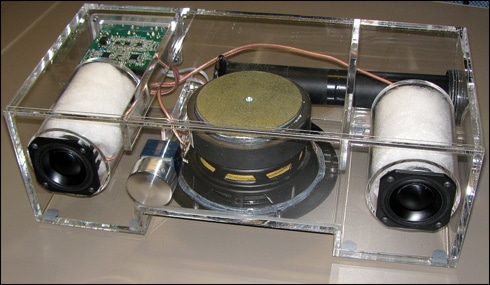The Class D, 2.1-Channel Audio Amplifier enhances sound across all volumes, essential for superior audio in entertainment and communication.

An audio amplifier is crucial in sound systems because it boosts low-level audio signals to a level suitable for driving speakers, ensuring clear, powerful sound output. This enhancement allows listeners to experience high-quality sound across various volumes, making amplifiers indispensable in both entertainment and communication devices. The reference design of a Class D, 2.1-Channel, Audio Amplifier by Analog Devices (ADI) is built into a single, finely calibrated box enclosure that houses all the electronics and speaker components. It only requires an external power supply and a signal source to function fully.
This system incorporates two 2-inch loudspeaker drivers for the stereo left and right channels, and a 5-inch loudspeaker for the subwoofer. A single MAX98400A amplifier operates in stereo mode for the left and right channels, while another MAX98400A is configured in mono mode to drive the subwoofer channel. The design is detailed in two main parts: the electronic circuitry and the speaker/enclosure assembly.
The design boasts several key features, including a compact all-in-one format that operates on a single 12V to 20V DC power supply. It achieves high SPL output from a small enclosure and utilizes a high-efficiency Class-D architecture. Additionally, it includes active EQ with dynamic bass equalization, ensuring excellent sound quality using cost-effective drivers.
The input stage serves both the left/right channels and the subwoofer. A stereo, log-taper digital potentiometer controls the volume by adjusting the signal level to the preamplifier. To prevent ground loops, the input uses differential sensing, and the RCA input connectors are isolated from the system ground.
The design incorporates three channels for speaker power amplification. A MAX98400A amplifier is set up in stereo mode to drive the left and right speakers, providing 8Ω. The same model, configured in mono mode, serves as the amplifier for the subwoofer channel. By connecting the two Class D outputs of the MAX98400A in parallel in mono mode, the subwoofer channel can output 44W into 4Ω. The input stage for the subwoofer uses the same configuration as the left and right channels. After this stage, the signals for the left and right are combined through U5-B to form the mono subwoofer output. The gain for the subwoofer channel at the summing amplifier is set by R303.
The subwoofer employs a 5-inch diameter Tymphany model SLS-P830945 loudspeaker, which has a nominal impedance of 4Ω and a resonance frequency of 47.4Hz. For the left and right channels, 2-inch Tymphany model PLS-P830970 loudspeakers are used, each with a nominal impedance of 4Ω and a resonance frequency of 147.5Hz.
ADI has tested this reference design. It comes with a Bill of Material (BOM), schematics, etc. You can find additional data about the reference design on the company’s website. To read more about this reference design, click here.








